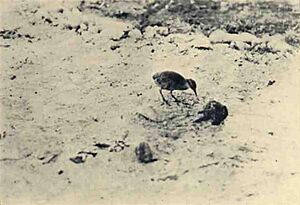Wake Island rail facts for kids
Quick facts for kids Wake Island rail |
|
|---|---|
 |
|
| Photo from a 1936 book | |
| Conservation status | |
| Scientific classification | |
 |
|
| The Wake Island rail lived on Wake Island, a 3 islet atoll | |
| Synonyms | |
|
Hypotaenidia wakensis Rothschild, 1903 |
The Wake Island rail (scientific name: Hypotaenidia wakensis) was a special bird that lived only on Wake Island. This island is a small group of three islets in the Pacific Ocean. The Wake Island rail was a type of rail, which means it was related to birds like coots and moorhens. What made it unique was that it couldn't fly! Sadly, this bird became extinct during World War II because of hunting and habitat loss.
It lived on the islands of Wake, Wilkes, and Peale. Peale Island is separated from the others by a channel about 100 meters wide.
Contents
What Did the Wake Island Rail Look Like?
The adult Wake Island rail was about 22 cm (9 in) long. Its wings were small, measuring between 8.5 and 10 cm (4 in) across. The tail was about 4.5 cm (2 in) long. Its beak was between 2.5 and 2.9 cm (1 in) long. Its legs were about 3.3 to 3.7 cm (1 in) long.
This bird had dark grayish-brown feathers on its back and head. Its face, including its cheeks, was also dark. The feathers on its belly and chest were ash brown. These parts had thin, white stripes. Its upper throat and chin were whitish. A gray stripe went from its chin, over its eyes, to its beak. The beak, legs, and feet were brownish.
The Wake Island rail was closely related to the buff-banded rail (Hypotaenidia philippensis). That bird lives in the Philippines and can fly. Scientists believe the Wake Island rail evolved from a flying ancestor.
How Did the Wake Island Rail Live?
Scientists don't know much about the Wake Island rail's daily life. However, a study in 2011 gave us more information. In 1903, when it was first studied, there were many of these birds.
The Wake Island rail lived in areas with Cordia subcordata bushes. It ate molluscs, insects, worms, and seeds. It would use its beak to dig through leaves and soil to find food. There was no fresh water on the island. So, scientists think the bird could live without drinking water. It likely got all the water it needed from its food.
Nesting and Family Life
People saw the Wake Island rail on Peale islet in the late 1930s. This was when a hotel and seaplane port were being built there. Some of the last birds for museums were collected during this time. People also saw the birds eating hermit crabs. A photo from that time shows a nest with four eggs.
The birds made simple, saucer-shaped nests on the ground. These nests were hidden in thick plants. The eggs had a speckled pattern to help them blend in. This was a type of camouflage.
The breeding season started in late July. Nesting began in mid-August. If conditions were good, a pair might raise two groups of chicks a year. Small groups of birds would nest together. The adult birds would care for their young for a long time. They would also feed them. This likely helped protect the chicks from predators. These predators included hermit crabs (Coenobita) and the Polynesian rat (Rattus exulans). The rails and rats lived together on the island.
In 1923, a bird expert named Alexander Wetmore observed the Wake Island rail. He said the birds were very curious. But they would quickly run into cover if disturbed. Their call was a soft cluck or a low chattering sound.
Why Did the Wake Island Rail Become Extinct?
The Wake Island rail is now completely extinct. It could not fly, and it lived on a remote island. The bird was also very curious and not afraid of humans. These things made it an easy target for hunting.
The extinction happened specifically between 1942 and 1945. This was during World War II. Thousands of Japanese soldiers were stuck on Wake Island. This happened after the U.S. military blocked the island. The Japanese had invaded and taken over Wake Island in December 1941. The soldiers were starving and hunted the birds for food.
Also, the island's habitat was destroyed. This was due to fighting and heavy bombing by both Japanese and U.S. forces. The combination of hunting and habitat loss led to the bird's extinction.
Because of this, scientists had little time to study the bird. There are only a few samples, photos, and scientific papers about it. By the early 2000s, very few people who had seen the bird were still alive.
Other Similar Birds
The Wake Island rail is not the only flightless bird on a remote island. For example, the Inaccessible Island rail lives on an island in the South Atlantic. Scientists have asked similar questions about how it came to be there.
See also
- Inaccessible Island rail (Another rail on a remote island)
- Barred rail (Another rail common in the Pacific islands)
- List of birds of the United States Minor Outlying Islands


